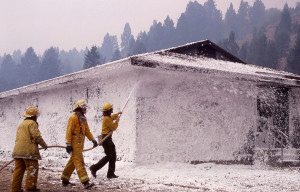
By Sophia Arnao, Researcher and Guest Writer for Save The Water™ | January 31, 2016
What is Perfluorooctanoic acid?
Perfluorooctanoic acid (PFOA) is a chemical that most people have probably never heard of. However, it is more common than we realize and can be potentially harmful to humans, animals, and the environment. The EPA categorizes it as an “emerging contaminant,” meaning it is a chemical that poses a potential or real threat to human health or the environment.1 In fact, already there have been several studies that link it to cancers, tumors, and birth defects.
Where is it found?
PFOA is one of the most widely used perfluorocarbons (PFCs). PFCs are known for their strong carbon-fluorine bonds, so they are very hard to break down once they enter the environment. PFOA has lipid-repellent and water-repellent qualities, so it is used to produce products aimed to achieve a “non-stick” effect: most notably, Teflon. However, the American Cancer Society states that PFOA is burned off in the process of making Teflon, so the chemical should not be seeping into your food through non-stick pots and pans.2 On the other hand, working at a Teflon plant and other places where PFCs are processed is a different story, as workers are exposed to the chemicals firsthand.3
There are other places where PFOA is prevalent, including military bases where firefighters are trained to extinguish fires from combustible liquids such as jet fuel. Since these types of fires are so intense, they will not necessarily die when water is poured over them. They require a substance to smother them, and Aqueous Film Forming Foam (AFFF) does the trick. Before 2002, chemical giant 3M manufactured PFOS-based AFFFs, made from another PFC called perfluorooctanesulfonic acid. However, they completed a phase-out process of those in that year, and now, most AFFFs are fluorotelomer-based. These contain neither PFOS or PFOA in their original form; however, over time, they can break down into PFOA.4
What is the environmental and health impact?
Due to its composition, PFOA is very hard to break down, so once the AFFFs decompose into PFOA, the chemical remains in the environment for a long time. It can easily migrate from soil to groundwater and stay in the water for long periods of time. It can travel through the water, potentially contaminating tap and drinking water sources. PFOA can also bioaccumulated in aquatic creatures and mammals, threatening the marine environment. Therefore, higher trophic levels are at risk of consuming concentrated amounts of PFOA, as these animals travel up the food chain.5 As for humans, higher concentrations of PFOA have been found in people living or working near AFFF-producing plants and military bases because more is likely accumulated there.1
Although epidemiologic evidence on the effects of PFOA is limited, studies have revealed that increased exposure in rodents caused tumors in the liver, kidney, and testicles. In addition, the studies showed that PFOA reduced birthweight and caused neonatal deaths in mice and rats.3 While the results in animals do not necessarily translate to those in humans, some cases are eerily similar. Lori Cervera, a woman living near a military base in Pennsylvania where PFCs are used, was hospitalized for kidney pain, which turned out to be a cancerous tumor. She didn’t understand why until she learned later that the well she used for drinking water was contaminated with elevated levels of PFCs. That same year, tests revealed that almost 50 public and private wells near her township were also contaminated with dangerous PFCs levels.4
Alternatives and opportunities for future research
Is fluorochemical water contamination a risk worth taking in order to prevent damage from large-scale fires? It turns out there may be other options. One alternative would be to create a foam free from fluorochemicals completely, so that it could not decompose into PFOA. Melkote, Wang, and Robinet compiled a paper regarding these fluorine-free foams and found that the first-generation models showed some improvements from other AFFFs.6 They were not bio-persistent or bioaccumulative like their fluorotelomer-based counterparts; however, they showed higher levels of acute aquatic toxicity. The second-generation foams they proposed had lower toxicity, so they concluded that fluorine-free foams were a possibility. More recently, scientists at ITMO University in Saint Petersburg and a research company, SOPOT, worked together to develop a new foam made of inorganic silica nanoparticles that is not only biodegradable, but may have more fire extinguishing capabilities than current substances.7
In conclusion, although research on PFOA is still not definitive, it appears there are definite risks. People living near places that might use PFOA in large amounts (such as military bases and fluorochemical plants) should be cautious of their drinking water supply, and they must be vigilant in protecting themselves and others. Hopefully, alternatives to the fluorotelomer-based AFFFs will be proven effective, and firefighting will not only help keep people safe by putting out fires, but will also protect the environment by not polluting the soil and water sources with PFOA.
References
- U.S. Environmental Protection Agency (EPA). 2014. “Emerging Contaminants – Perfluorooctane Sulfonate (PFOS) and Perfluorooctanoic Acid (PFOA).” http://bit.ly/1QbweBI
- American Cancer Society. 2013. “Teflon and Perfluorooctanoic Acid (PFOA).” http://bit.ly/17CjuD7
- Kyle Steenland, Tony Fletcher, David Savitz. 2010. “Epidemiologic Evidence on the Health Effects of Perfluorooctanoic Acid (PFOA).” http://researchonline.lshtm.ac.uk/ 1616/1/ehp-0901827.pdf
- S. Lerner. 2015. “Special Report: Toxic Firefighting Foam Has Contaminated U.S. Drinking Water.” http://bit.ly/2sEL5yv
- Jimmy Seow. 2013. “Fire Fighting Foams with Perfluorochemicals – Environmental Review.” http://www.hemmingfire.com/news/get_file.php3/id/287/file/Seow _WA-DEC_PFCs_Firefighting_Foam_final_version_7June2013.pdf
- National Fire Protection Association. 2012. “Next Generation Fluorine-Free Firefighting Foams – NFPA.” http://bit.ly/2u1qw2S
- ITMO University. December 14, 2015. “New ceramic firefighting foam becomes stronger when temperature increases.” http://phys.org/news/2015-12-ceramic-firefighting-foam-stronger- temperature.html

